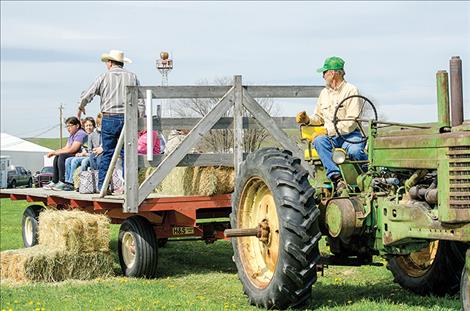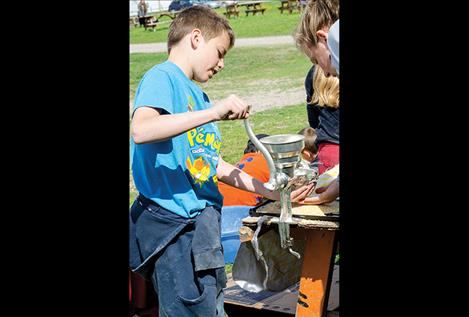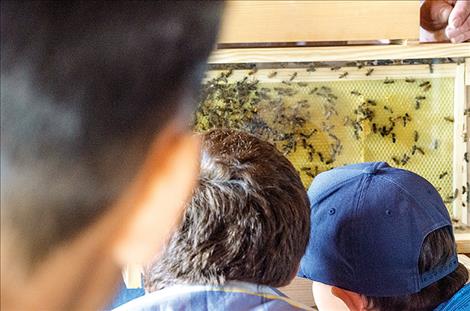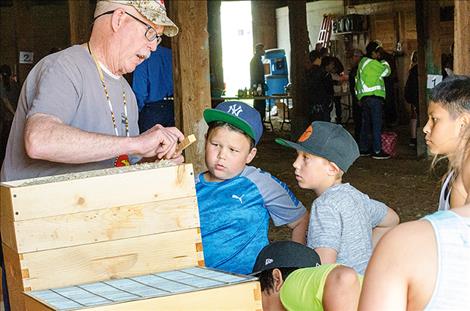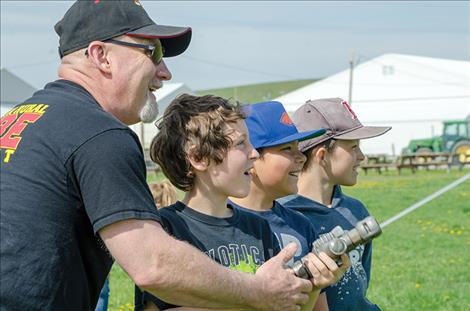Students learn origins of food, explore ag-related topics
Hey savvy news reader! Thanks for choosing local.
You are now reading
1 of 3 free articles.
POLSON – Joey Fulwiler, fourth grader, looked into an observation box full of bees moving about. He put his ear close to the clear partition and listened.
“I heard their wings buzzing,” he said. “They sound cool.”
Joey was participating in the annual Fourth Grade Ag Days on Friday at the Polson Fairgrounds with students from his Ronan elementary class and many others.
The students toured 13 stations during the two-day Lake County Conservation District event to learn about the many aspects of agriculture. Heidi Fleury, Conservation Coordinator, said about 350 students attended from schools including Ronan, Pablo, Polson, Valley Christian, Valley View and Dayton. Among other things, students learned that wool comes from sheep and that cereal and many foods start out as grain.
Volunteer Chuck Lewis brought bees to the event in an effort to educate students about the necessary work the little creatures do. “They are pollinators,” Lewis said. “Without them, you would have things like tomato plants but no tomatoes.”
Lewis does another project with bees aside from the event that he calls Plan Bee. He teaches military veterans how to raise honeybees and take care of a wooden hive. He explained that the bees help keep the veterans focused on a task while working through post-traumatic stress disorder.
He said people can help support the bee population by providing them with a habitat full of wildflowers. The conservation district has a seed program available for anyone who is interested.
Jane Clapp sat on the back of a horse in a corral and talked to the kids about basic horse training with assistance from Frank Galiardo. He handed her a giant teddy bear to demonstrate how the horse might react to a calf being put on its back, and the horse reacted perfectly by standing still.
“This is how we produce well-trained ranch horses,” Galiardo said. “We think it’s important kids learn about horses and ranch life. They don’t get to do that as much anymore.”
Clapp finished with one group of students and took a few moments to explain that she has participated in the event for the past 11 years, although it used to be held on a ranch. It was moved to the fair grounds for convenience. “This is the fourth or fifth year it’s been out here,” she said.
Susan Lake of Lake Farms talked to the students about local potato production. She said science and technology help farmers feed the world everyday. “Better technology has allowed us to improve and produce more crops with less space,” she said.
She added that a small fraction of the soil in the world actually grows food after considering what is covered with water, desert, mountains, swamps and rocks, so taking care of the soil is very important.
Chickens were in the barn clucking as 11-year-old Lina Sturman taught the students about 72 different breeds. “That isn’t even all of them,” she said. Her favorite is the one with the 28-foot long tail. She said she likes sharing information with people and helping them learn about where their eggs come from.
Polson Rural Fire Department volunteers were at another station to talk to the students about rural fires that can occur on open farmland and other wildland areas.
“Most of the fires around here happen from July to August,” said Jack Clapp, department chief. After going through a list of causes from campfires to matches, it was determined that lightning is the cause of most local fires.
Clapp offered a bit of encouragement for kids thinking they’ll never need the math skills they are learning in school. He said firefighters use math all the time. He gave them an example: if a fire truck carries 500 gallons of water and the hose sprays 30 gallons a minute, how long will it take for the truck to run out of water? The answer was important to know so a firefighter wasn’t left standing in front of a blazing fire without any water.
After a bit of head scratching and problem analysis, it was determined that the water would last for about 16 and a half minutes, and if it was a big fire, the chief better get someone to bring in more water with another truck.
With the math puzzle complete, students quickly lined up to get a chance to try spraying the fire hose with help from volunteer firefighter Jeff Veach. Firefighter Carol Swope was on hand to help with the station as well.
While students sprayed water, another small group was riding on a trailer, pulled by a tractor driven by Curt Rosman. Sigurd Jensen was on the trailer talking to the kids about invasive weeds like whitetop and pointing out an osprey nest. The team is with the conservation district. They said they hope to be back next year to share more information with another group of fourth graders before the tractor pulled away from the loading zone to loop around the fairgrounds.
















